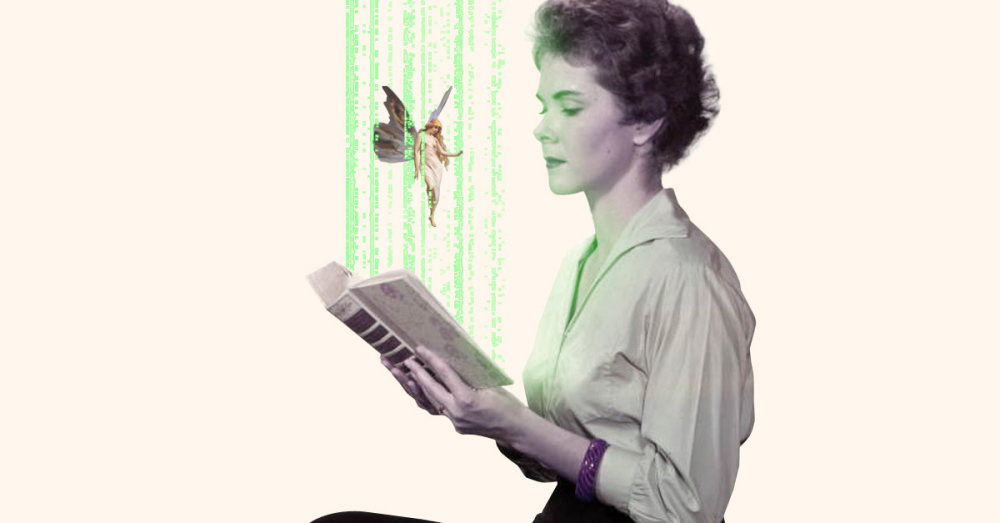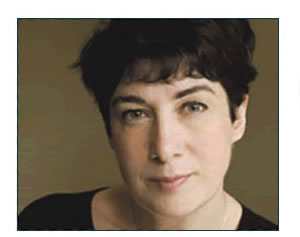Imagination and the Age of Reason: Magic is Metaphor for Power of Mind

Editor’s Note: Joanne Harris is the author of Chocolat and more than a dozen other books. This piece originally appeared on Harris’s Tumblr blog and is reproduced here with the author’s permission.
The Age of Reason is a term generally used to refer to one of two concepts. First, the rise of our society from out of the Dark Ages of superstition, ignorance and religious oppression: and two, the age at which a young child learns to process and articulate the difference between reality and dream.
A child who announces that he has seen fairies in his garden is treated with amused indulgence and praised for being imaginative: an adult doing the same thing is assumed to be a liar or more likely, mentally ill.
How can we justify this shift in attitude? An imaginative child is generally perceived as an intelligent child. As educators and parents, we try to encourage our children to think imaginatively. We read them fairy stories. We tell them little fictions about Santa Claus and the Tooth Fairy. We encourage them to play role-playing games, in which they assume the identities of fictional characters; princes; knights; superheroes; animals. These things are all designed to develop the imagination – and then comes the age of reason, at which point the adult world begins to deliver a wholly conflicting message: that none of that matters any more, and that at a certain age, children should put aside childish things and concentrate on the real world.
Here we have perfect illustration of the modern era’s division between reason and imagination. Reason, we are led to believe, is what can be proved through logic. Reason is the enemy of dreams and wishful thinking. Reason is science—a word that translates, etymologically, as what we know—whereas imagination is what we create for ourselves in our minds, with no apparent connection between the fictional world and the real one. The Age of Reason is therefore the age at which intelligence—the function of the brain’s capacity to rationalize and process information - is valued and trusted more highly than its dream potential.
At last year’s Cheltenham Festival, Richard Dawkins made the following comment on the subject of fairy stories; that it is “… pernicious to inculcate into a child a view of the world which includes supernaturalism—we get enough of that anyway.”
His words imply a belief that telling fairy stories is not only dangerous, in that it encourages children to believe in impossible things, but that these fictions act as a means of training them to embrace the larger fictions of superstition and religion—areas still governed by the dark half of the human brain, as yet unenlightened by reason.
To Dawkins, it seems that fairy stories and the Dark Ages have a lot in common. They are the natural enemies of reason, logic and science. They represent a backward time in the evolution of Man, in which people were governed by irrational fears and emotions rather than the evidence of their senses. Pernicious supernaturalism is the enemy of progress: it has led some of the cruellest and most destructive phases in human history; it has been responsible for the destruction of most of humanity’s literature, sculpture and artwork.
And yet, the greatest achievements of Man have come from that dark half of the brain that looks at things previously deemed impossible – electricity; space flight; social equality; men on the moon - and brings them, kicking and screaming, into the world of here and now.
How can we reconcile the two? Can living in a dream world ever help us in real life? Can irrational thinking be a creative, progressive force? Can the constraints of the fairytale help us to be truly free?
I think they can. But first we need to look at the role of those fairy stories, and their purpose in a rational world. Why do we tell stories? Why are so many of them set in fantasy worlds, where physics and magic collide, and where races of imaginary beings battle fearsome monsters? Is it because our own world has become too much to bear that we feel the need to escape into another reality?
This is the argument laid out by those who mistrust fantasy; who feel that irrational thinking is backward, primitive thinking. I disagree – not least because of our shared human history of inspired, imaginative thinkers and dreamers, who dared to embrace possibilities that had not yet been conceived of.
Because imagination is not about escaping from reality. It is the art of the possible. It teaches curiosity and flexibility of thought—both essential to the process of scientific discovery. And stories,—even fairy stories; perhaps especially fairy stories - teach us to look behind fiction and see the truth that it conceals. Picasso said that anything that can be imagined is real. Thus, fictional worlds, even the most fantastic, are merely reflections of our own world, glimpsed through a distorting lens.
“So—where do you get your ideas from?“
It’s the question every artists dreads. We try to get round it in various ways, by making jokes (my standard response tends to be; “Goblins bring them during the night”), but actually the answer is this: “They come from somewhere in my brain.”
But the brain, for all its mysteries, isn’t a Magic Eight-Ball. It’s an organ that enables us to process what we experience. Everything we see and hear; everything we suffer; everything that brings us joy is filtered through memory and imagination to create a personal narrative that reflects our world and the things we think are important. Writers shape these narratives into stories for other people to read; an expression of our shared experience and humanity.
Some of these stories are metaphors, peopled with dragons and monsters and gods. But sometimes it’s easier to express our deepest fears and concerns through metaphor. Feelings are inarticulate. This doesn’t make them any less real. And sometimes the reality of our deepest thoughts and fears can only be accessed through story, and conquered by the imagination.
That’s why the original fairy stories by Perrault and the Brothers Grimm were so unflinchingly bleak and challenging. In these stories, children die, are abandoned, are victims of incest and abuse; love is often cruel; good does not always triumph over evil. In spite of the trappings of fiction, it represents a portrait of a world dominated by cruelty, unhappiness, war, disease and poverty. Magic, witches and unicorns aside, it’s a far from fanciful portrait. It is a view of reality, filtered through a lens of hope; hope that love can save us; that monsters can be defeated; hope that magic may exist – the power to change our destiny.
Nowadays, these stories have been sweetened and adapted. Disney has much to answer for. And yet, our world is no less bleak, with its nuclear weapons, world wars and terrorist organizations. The monsters of myth and fairy tale have different faces nowadays, faces that some of us would rather not see. But stories sometimes allow us, not only to expose those monsters, but to show us ways of fighting against them and defeating them in real life. Through a glass darkly, stories reflect our world and the monsters it contains. To limit the darkness in stories is to take away the very thing that gives us the power to fight back against cruelty; racism; prejudice; fear.
As a society, we claim to value Reason in all its forms. And yet, we are governed primarily by Unreason: by instinct; by all the inarticulate, buried emotions that dictate our movements and deeds. People like Richard Dawkins believe that by suppressing these emotions and by embracing Reality, we will as a species reach the Age of Reason, leaving the messy, irrational part of our psychological makeup behind.
I believe that to dismiss the power of the irrational mind is the sign of a person in denial of what it means to be human. Feelings are inarticulate, yes. They sometimes emerge in surprising ways. Feelings are unpredictable, awkward and irrational. But like it or not, this irrational part of the mind is also an integral part of the engine that drives it; the creative imagination that overcomes all obstacles in its attempt to fulfil its dream – be that an end to slavery; travel to another world or simply the dream of true love – in the course of its personal narrative.
And stories are the language of this buried world of emotions. By understanding and accepting them, we can learn to harness and use the power of imagination – a power so great that, in stories, it often translates as magic.
But magic is just a metaphor for the power of the mind. The words we associate and use with fairytale magic are also the words that we associate with certain human qualities. Glamour. Charisma. Charm. Enchantment. Qualities which, far from being supernatural, imaginary or irrelevant, inspire the devotion of others, and lead to the great imaginative leaps that created our civilization.
There’s no such thing as a fantasy world. There’s no such thing as supernaturalism. There is only the lens of the human imagination, powered by human intelligence, levelled at reality to enable us see the world as it is, as a changing, filled with possibilities.
So - read stories to your children. Read stories to each other. Imagine worlds. Feel feelings. That’s what it means to be human. Don’t be afraid of unreason, or magic, or fairies, or darkness.
Intelligence is the vehicle. Imagination is the road. Where it leads is up to you. Just enjoy the journey.

Joanne Harris is the author of Chocolat (1999), which was made into a movie starring Juliette Binoche and Johnny Depp, and more than a dozen other books. You can follow her on Tumblr or on Twitter @Joannechocolat.
Joanne Harris
